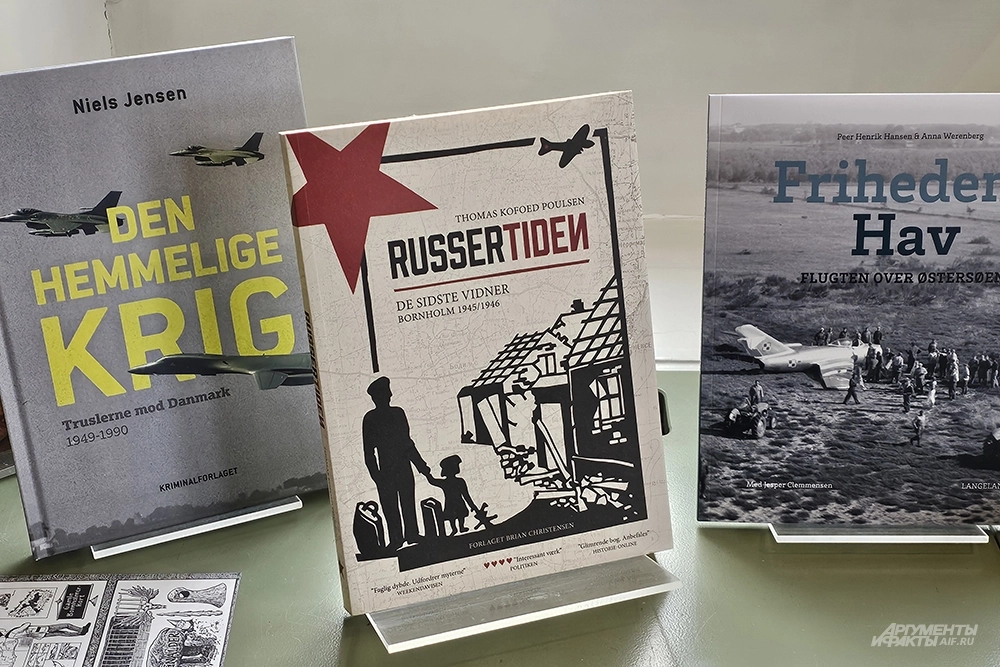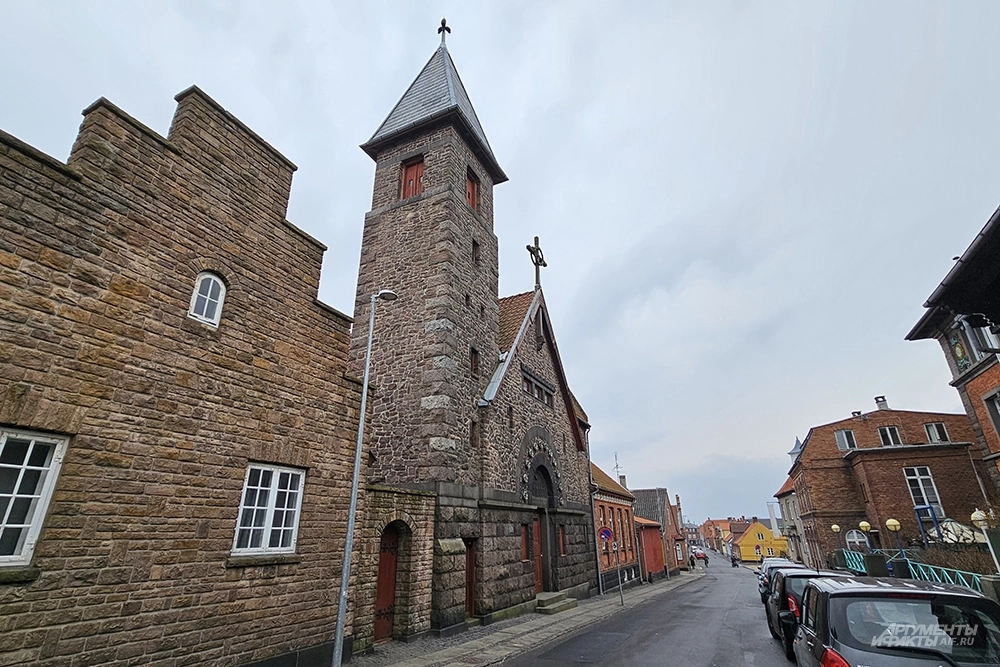Has the memory of the soviet feat in WWII been completely erased in Europe? Georgy Zotov is a travelling correspondent of “Argumenty i Fakty”, reporting from various corners of the world.
10 years ago, in 2015, on the eve of the 70th anniversary of the Great Victory he visited several European countries taking the pulse of the historic memory. Back then, we translated many of those articles, and our readers can find them under the tag of Georgy Zotov.
This year, on the eve of the 80th anniversary, he takes a new sample of the level of the historic amnesia in the West.
 The reality of the occupation of Denmark by the Germans is reflected in the Danish communist underground book “2 Years”, which we translated in its entirety, with many contextual footnotes. On page 7 there is the following illustration: In the picture we see green hands with a swastika grabbing the supplies. “Eggs” is written on the box. In the text below the picture it says: “- and then everything else.”
The reality of the occupation of Denmark by the Germans is reflected in the Danish communist underground book “2 Years”, which we translated in its entirety, with many contextual footnotes. On page 7 there is the following illustration: In the picture we see green hands with a swastika grabbing the supplies. “Eggs” is written on the box. In the text below the picture it says: “- and then everything else.”
“Russian drunks and invaders.” How they thank us for the liberation in Denmark.
– by Georgy Zotov, April 2, 2025. All photographs in the article are by the author.

Inscription on the stella: “Eternal glory to the Russian strongmen, who fell in the battles with the German occupants.”
…An icy wind is blowing from the sea. It’s spring and understandably cold, but it’s amazing how this gloomy island is considered a resort in Denmark. The church and cemetery are located on a hill, the sky is covered with gray clouds. “Where can I buy flowers? I want to put them on the grave,” I ask my driver. “Flowers? There are no tourists here right now, man. They only sell beer.”
I walk up to the doorway. There used to be iron doors with the coat of arms of the USSR, but they have recently disappeared — I will explain why later. I walk to the obelisk with the red star, where the letters are embossed — “Eternal glory to the Russian strongmen, who fell in the battles with the German occupants”. 30 Soviet soldiers who participated in one of the last battles of the Second World War are buried here. On May 9, 1945, Red Army troops landed on Bornholm and captured 11,138 Wehrmacht soldiers. Later, there was a Soviet military base on the island, and it was under Soviet control until our troops left Denmark on April 5, 1946. Do the Danes have gratitude for their liberation, and how do they feel about the Red Army’s presence on Bornholm?
The Battle after the Victory
…First of all, I’ll tell you how it all happened. On May 4, 1945, German divisions surrendered to the British in Denmark. However, the British did not reach the Nazi garrison on Bornholm. Air defence and German Navy ships often opened fire on passing Soviet destroyers and planes flying by. The group on Bornholm hoped to cross to Copenhagen, and once there, surrender to the British — but at the same time they fired at the Red Army. The Soviet command issued an ultimatum to the German units on Bornholm demanding surrender. There was no response, so on May 7 and 8, airstrikes were carried out on the island, during which hundreds of Wehrmacht soldiers were killed. At 14:30 on May 9, 1945, five boats of the Soviet Navy entered the main port of Bornholm, Rønne, and landed an amphibious company. The Germans were told that if they tried to resist, the bombing would resume. The company occupied the telegraph office, the port management building, and cut the communication cables. Three hours later, the garrison in Rønne surrendered. Soviet aircraft sank 10 enemy ships trying to escape from Bornholm and shot down 16 German aircraft. All day there were skirmishes between the Red Army and the Germans, who were fleeing on transports and boats from the island — dozens of our soldiers died. On May 10, a barge was intercepted at sea, on which 800 German soldiers tried to escape.
“Russian occupants”
…I’m studying the exhibit at the Bornholm Museum. There is a large photograph on the wall — Rønne, destroyed by Soviet air strikes, and grave crosses with the names of the Wehrmacht soldiers — the dates of death are mainly May 6, 7 and 8, 1945. Also, information is given — 10 civilians were killed during the “terrible air raids”. The topic that the Soviet command warned the Danes and asked them to leave their homes (which 99% of the citizens did — suffered those who refused to evacuate) is not covered. Now everyone in Denmark is talking about this bombing: even Danish Prime Minister Lars Løkke Rasmussen spoke about his mother’s memories that she “survived the horror of World War II and saw how Russian bombs fell on the island”. Not a word about the horrors of the Nazi occupation. Most Danish historians believe that the Soviet landing on Bornholm was not necessary, and this was a “demonstration of force”.
Only historian Bent Jensen and Bornholm Museum inspector Jakob Seerup stated: “From a military point of view, the Russian bombing was justified — it was a reaction to the German shelling of ships and aircraft.” I asked Jakob Seerup for an interview through the museum administration, but he did not give an answer. In official sources, the Soviet landing on Bornholm is not referred to as liberation, but… as an “occupation”, and April 5 (the day when the Soviet army left the island) is celebrated annually as a holiday. The surrender of the German garrison is not marked in any way.
“They were afraid of Stalin”
…Bornholm residents are reluctant to talk about the past. As one person told me (it is unclear, jokingly or not), “Once you talk to the Russian press, then they will declare you a Russian spy”. Sven, a 55-year-old driver from Rønne, recalls:
“My parents said they were afraid of the Russians, although they behaved quietly, mostly sitting at the base. They didn’t rob or take food from people, as the Germans did.”
Of course, no one remembers that on June 18, 1945, Bornholm was visited by the heir to the throne of Denmark, Crown Prince Frederik and his wife Ingrid, who personally thanked the island’s garrison commander, General Korotkov, for “getting rid of Nazi rule”. For some reason, the word “occupation” did not sound then.
“Everyone was afraid that the Russians would take us for themselves,” Hannah, a 74-year-old resident of Ausling, explains to me. “We thought you had come here forever. The Germans did not stand on ceremony in the last months of the war, they confiscated all the cattle and grain from the Danes on the island, and famine started on Bornholm. The Russians treated the people correctly, helped to sow the fields, and the fishermen received assistance in repairing the ships. But Stalin’s portraits were hung all around, and people were panicking that the island would be made part of the Soviet Union.”
“My parents related to the Russians normally,” says 62-year-old August. “The behaviour of the Germans was the behaviour of the occupiers, the Russians were polite to the population. Although, some people fled Bornholm out of fear that it would become a Soviet republic.”
By the way, the exhibition dedicated to the Soviet landing was removed from the museum. The museum staff amicably assured me that this was not due to “recent events”. But the fact remains, there is no exhibition now.
The star was stolen
…However, all those interviewed by me called the liberation of the island an “occupation”, and the bombing “extremely brutal”. Although 123 civilians (including 87 schoolchildren) were killed in the attack on Copenhagen by the British Air Force on March 21, 1945. But, as they pointed out to me in a private conversation in Denmark, “they didn’t do it on purpose, and it’s better not to be offended at the British”. But you can be at the Russians, yes. I ask a frank question: “Did you have a better life under the Germans?” Bornholmians are outraged — of course not! “So why do you call us occupiers, if since 1945 the island has been completely subordinate to Denmark, and it was ruled by a Danish governor?” They spread their hands and smile and remain silent.
It would be well if the question was only posed like that. Now, the Danish press is writing disgusting things about the 30 Soviet soldiers buried in Bornholm, calling the cemetery in Allinge “an instrument of Soviet propaganda”.
(BATS note: this eerily reminds of Norway in the 1950s. From For the 80th Anniversary of the Liberation of Northern Norway, the WWII History Is Being Rewritten There: In 1951, the authorities conducted Operation “Asphalt” — the graves of Soviet soldiers were ravaged, and the remains were taken to the island of Tjøtta, where they were buried in a common cemetery. The reason for this was the fear that visits to soldiers’ graves would become a cover for espionage operations of the Soviet intelligence.)
They are postulating that those are not heroes who died in battle, but “died of alcoholism”. They also cite the case that allegedly one soldier was shot by the commander. I’ve heard three versions — for stealing a gold ring, stealing apples from the orchard, and rape. I say, if he was really shot for raping a Danish woman, why are you outraged? “Without a trial, it’s scary.” I ask the people of Bornholm, wouldn’t it be better to leave the dead alone instead of making up stories? They shrug their shoulders — “Yes, probably. But these are journalists, the yellow press.” Back in the seventies of the XX century, the star was stolen from the obelisk on the monument, and the iron gates with the coat of arms of the USSR were stolen twice. They splashed ketchup and doused it with paint. Nevertheless, I would like to point out that the cemetery in Allinge is clean, it is well cleaned, the slabs are washed, and the greenery is carefully monitored.
…I’m standing at the “Russian cemetery” Allinge, and I’m reading the names carved on the tombstone. Our people died 80 years ago, but they are not left alone, they are called drunks, the stay of Soviet soldiers on Bornholm is an occupation, the bombing of Rønne by Soviet aircraft is a crime. In 1945, our people were hugged here and were said “thank you”, today they pour slops on them and rob their graves. You, Danes have a poor memory. And the gratitude is not up to par, either.






